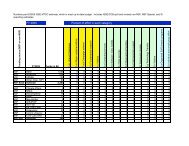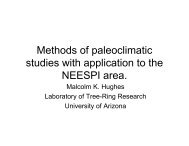Ground Truth Studies Teacher Handbook - Aspen Global Change ...
Ground Truth Studies Teacher Handbook - Aspen Global Change ...
Ground Truth Studies Teacher Handbook - Aspen Global Change ...
You also want an ePaper? Increase the reach of your titles
YUMPU automatically turns print PDFs into web optimized ePapers that Google loves.
Investigating the Invisible (continued)<br />
Procedure<br />
1. Ask your students to think and talk about what<br />
“invisible” means. For example, how do they know<br />
that something exists if they cannot see it. Have your<br />
students form small groups to choose one “invisible”<br />
phenomenon. These groups should then research and<br />
figure out how they can verify its existence.<br />
2. Students examine the measurement tools and<br />
consider what they are called. This provides a good<br />
lesson in language and root words. Roots such as<br />
meter and scope are paired with thermo, tele, micro,<br />
etc. When students learn some of the basic meanings,<br />
they can figure out for themselves what related, but<br />
unfamiliar, words mean.<br />
3. The groups should use their tools to measure their<br />
invisible phenomenon every day for a designated<br />
period of time, preferably long-term. Have them<br />
chart and/or graph their data and post it in a special<br />
place in the classroom designated for the “Daily<br />
Invisible Data Set.”<br />
4. In some cases, the students may be collecting the<br />
only daily information on a particular subject and it<br />
may be of interest to the wider community. For<br />
example, if students measure ultraviolet-B, they<br />
could issue UV-B alerts the way weather reporters<br />
issue smog alerts. They could warn fellow students<br />
or even the entire community (via school newspapers,<br />
public access cable, local newspapers, etc.) of<br />
an increased need for hats, sunscreens and sunglasses<br />
on high UV-B days. They could visit tanning salons<br />
and measure the UV-B output of the machinery to<br />
determine if it falls within federal guidelines.<br />
5. Students studying radon could test radon levels in the<br />
school basement, in their classroom and in their<br />
homes. They could read recently published information<br />
about radon and the controversy surrounding its<br />
relative danger.<br />
Discussion<br />
Bring the different groups together to discuss their<br />
experiences and share their data. Let them present their<br />
measuring devices to the other groups and explain how<br />
their device functions and how it verifies the existence of<br />
the phenomenon they are measuring. Bring up the topic<br />
of the nature of “invisible” phenomenon and discuss how<br />
their perception has changed.<br />
Extension<br />
1. Students collect their “Daily Invisible Data Set” and<br />
enter it into a computer which is networked (through<br />
EcoNet or other computer network) with other<br />
schools around the country or the world. The students<br />
compare their data with that coming from other areas,<br />
gaining a larger perspective on invisible phenomena.<br />
A forum for making, testing and sharing data from an<br />
inexpensive ozonometer is available on EcoNet.<br />
Plans for making a low cost UVB meter are available<br />
in the “Amateur Scientist” section of the August<br />
1990 issue of Scientific American.<br />
© ASPEN GLOBAL CHANGE INSTITUTE 1995 GROUND TRUTH STUDIES<br />
72


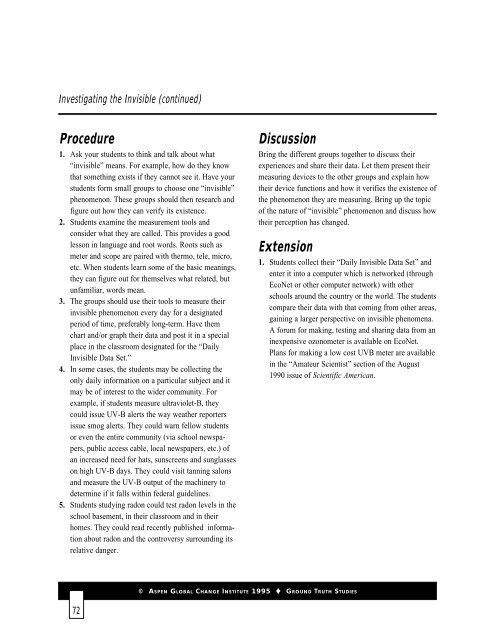
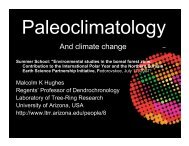


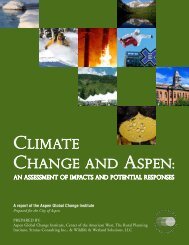

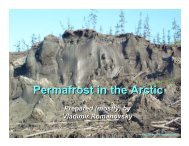
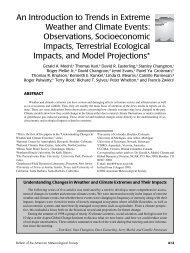
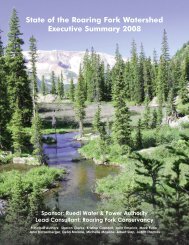
![View Powerpoint Slides [PDF]](https://img.yumpu.com/32486693/1/190x146/view-powerpoint-slides-pdf.jpg?quality=85)
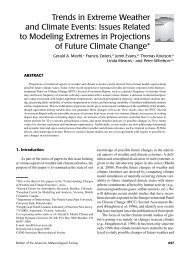

![View Powerpoint Slides [PDF]](https://img.yumpu.com/29411106/1/190x143/view-powerpoint-slides-pdf.jpg?quality=85)
